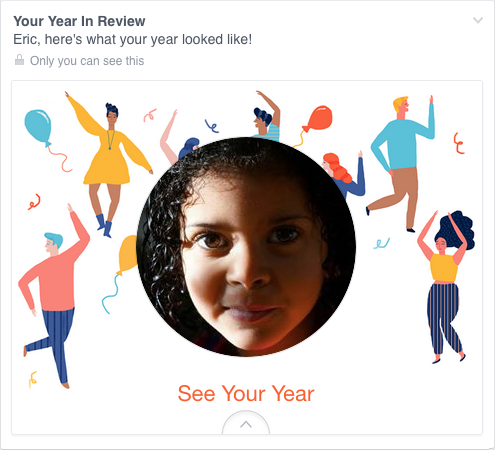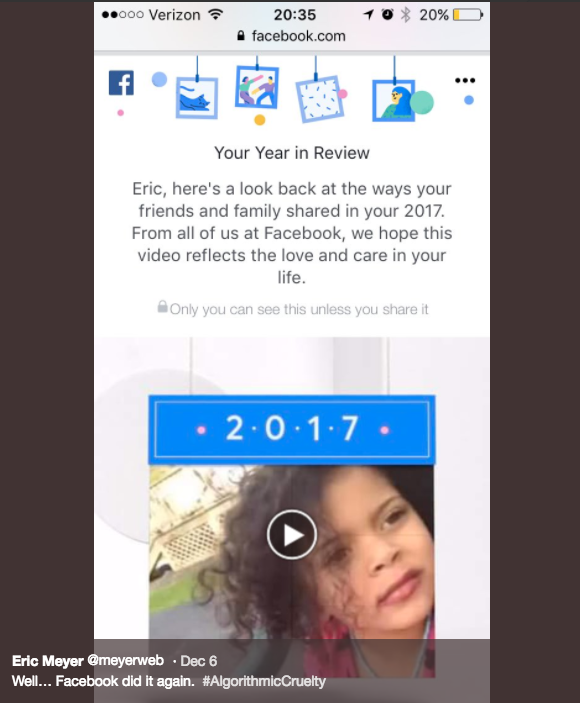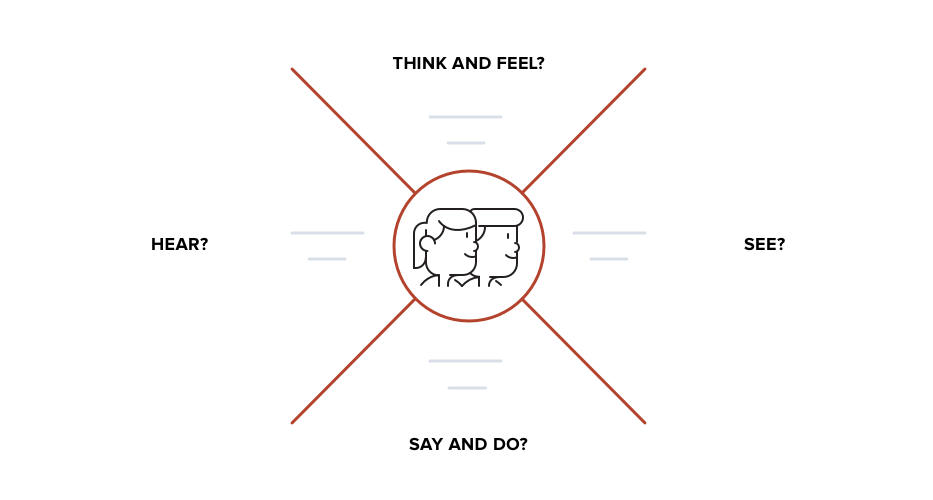Empathy Exercises for Winning Customers and Avoiding Losses

Facebook’s culture was built around the mantra “Move Fast and Break Things.” Little did they know the “things” they break would include elections, hearts, and even lives.
That’s exactly what happened to Eric Meyer one December morning. He opened Facebook expecting to find the usual updates from friends with pictures of their kids, holiday wishes, and random musings, not a cruel reminder that would leave him reeling for months. Instead, he saw Year in Review, a slideshow that had automatically been created to show his most popular posts from that year, surrounded by illustrations of balloons, people dancing, and a cheery headline: “Here’s what your year looked like!”
The platform’s designers and developers had all the best intentions. Year in Review would be a great way to drive engagement and remind people of the great memories they shared on Facebook that year, right?
The problem was that Meyer’s most popular post from the year was about his daughter, Rebecca. She had died that year on her 6th birthday. All of the sudden, the balloons and cheeriness weren’t just inappropriate — they were algorithmic cruelty.
And what’s worse, the exact same thing happened to him multiple times in the coming years, despite public backlash about the feature and Meyer (a well-known influencer in the design community) personally meeting with Facebook’s design team.
Sadly, Meyer’s story is one of many. For every faulty app like Year in Review, there are hundreds of shameful stories like Google Maps’ feature that showed users how many theoretical cupcakes calories they could burn by walking instead of driving, and dangerous algorithms that accidentally spread child exploitation content and tricked kids into watching violent videos.
These aren’t just “edge cases.” They’re stark examples of what happens when we forget that our users aren’t all picture-perfect, homogenous people who follow the “happy path” as they use our products and services.
Meyer’s colleague and co-author Sara Wachter-Boettcher put it well in an article for The Washington Post:
“Individually, it’s easy to write each of these off as a simple slip-up, an oversight, a shame. We all make mistakes, right? But when we start looking at them together, a clear pattern emerges of an industry that is willing to invest plenty of resources in chasing ‘delight’ and ‘disruption’ but one that hasn’t stopped to think about who’s being served by its products and who’s being left behind, alienated or insulted.”
How do we do better and fix things instead of breaking them? With empathy.
These aren’t just “edge cases.” They’re stark examples of what happens when we forget that our users aren’t all picture-perfect, homogenous people who follow the “happy path” as they use our products and services.
Empathy Explained
“Though we may know everything about our topic, we don’t know everything about our customers. Not even close. They have struggles and insecurities that affect the way they interpret our content and view our brand.” — Kate Kiefer Lee
Most of us think we know our users, but do our perceptions match reality? And how do their attitudes and behaviors change based on what’s going on in their lives, their interactions with our products and services, and everything else that affects their mood?
That’s why empathy is so important. It’s a vital step in understanding and identifying with another person’s context, emotions, goals, and motivations. As the second step in the design thinking process, empathizing helps find the answers to questions like:
- ”What are all the different types of people who use our product or service?”
- ”What makes them tick?”
- ”What are their attitudes about our product/service category in general? What are they looking for?”
- ”What are they thinking, feeling, saying, seeing, and doing on a daily basis?”
- ”How do those senses affect the decisions they make about our product or service?”
Empathizing is one of the most commonly skipped steps in the design process. Yet it often makes the biggest difference in producing positive results and avoiding major mistakes that cost money, reputations, and even lives.
Empathizing is one of the most commonly skipped steps in the design process. Yet it often makes the biggest difference in producing positive results and avoiding major mistakes that cost money, reputations, and even lives.
Empathy Exercises
There are tons of empathy exercises and research methods that help better understand the people using your products and services. Here are a few of our favorites that help gather real insights from real people and design experiences that are focused on them.
Customer Empathy Map
Customer empathy maps are super simple exercises that anyone can use to put themselves in their audience’s shoes and better understand their feelings, influences, tasks, pain points, and goals.
Here’s how to create a customer empathy map with your team:
- Write down the different types of people (or customer segments) who use your product or service. Pick one to start with.
- Brainstorm the types of things a person within that customer segment is thinking and feeling on a daily basis. What thoughts are going through their head, both positive and negative? What worries and aspirations do they have?
- Brainstorm what they’re hearing. What questions and comments are they hearing from friends, family, co-workers, and others that influence their decisions?
- Brainstorm what they’re seeing. What other products, services, and people are they interacting with? What do they see others doing?
- Brainstorm what they’re saying and doing. What tasks are they completing? What are they saying to the people around them?
- It may also be helpful to brainstorm the pain points this segment feels about your product/service category in general, the gains they’ll experience by using your product or service, and the common questions they’ll have during the sales process and customer experience.
Field Studies (or “Ride-Alongs”)
During a field study, your team goes out “into the field” to immerse themselves in a typical day in the life of your user. It’s the best way to observe how they actually use products in their natural environment, what external forces affect their decisions and actions, and what they actually do (as opposed to what they say they do). In fact, UX veteran Jared Spool describes field studies as “the fastest path to great UX” and explains that you can reap the benefits in as little as two hours every six weeks.
Surveys
Surveys allow you to ask your users a series of questions about their needs, wants, and/or experiences using your product or service. Some organizations have formal, scientific surveys created and distributed through a professional research firm, while others self-manage the process. Either way, they’re a good way to get basic feedback about your primary audiences’ emotions toward your brand or product, without spending extensive time and resources.
Interviews with Customers, Employees, and/or Stakeholders
Sometimes the simplest way to better understand what people think and want is just to ask them. Talking directly with customers helps uncover not only what they do, but also why they do it. If you don’t have access to real users, customer-facing teams like Sales and Support can share anecdotes plus trends they’re seeing in real time with executives and others who benefit from hearing that feedback, such as the UX team. This type of feedback brings reality to strategic planning and design (rather than operating purely based off assumptions), while offering a level of depth and context that’s often missing in written data and surveys.
Customer Journey Mapping
A Sample Customer Journey Map. Source: MappingExperiences.com
Journey mapping involves mapping out each step of the customer journey to see a visual representation of how people interact with and feel about your brand over time and across channels.
Here’s how to create your own:
- Gather stakeholders and research: Don’t forget to include stakeholders across the organization who have insight into what the user experience is really like, such as employees from Sales, Customer Support, and other teams who interact directly with end customers.
- Map out each touchpoint / step: Once you discuss the purpose and goals of this journey mapping exercise with your group, write down the chronological touchpoints or steps that one type of customer might take, from research to purchase to usage. Make sure to focus on one customer segment at a time. If there are multiple paths that the customer may take, document all of them to understand the various intricacies and options.
- Brainstorm actions, thoughts, and feelings: Next, think about what the customer is doing at each touchpoint / step, as well as what they are thinking and feeling in that moment. Write each answer on an individual Post-It Note, and place it under the related touchpoint.
- Step back, and look for strengths and opportunities: With a map in front of you that charts what the customer is doing, thinking, and feeling at each stage, the high points and low points of the experience become quite apparent. This will make it easy to identify and prioritize strengths and opportunities for improvement.
Bonus tip: Add a row to the map where you can write down common questions customers have during that stage of the journey. These ideas are a great source of inspiration for improving the design and copy of the product, brainstorming topics for blog posts, creating customer support content, and more.
Another advantage of journey mapping is that it helps build consensus and alignment among your team because it gets stakeholders involved, uncovers insights that may not come out in everyday conversations, and helps people feel more invested in the project’s success. Together, you’ll gain a better understanding of how your customers perceive your brand today, as well as how to improve it in the future.
Usability Testing
Usability testing is all about testing your product with real users to see if it works as you intended. It’s mostly commonly done after a product is built, but the best results come from testing before, during, and after development. Take a look at this article for tons of practical tips on conducting usability testing.
4 Simple Ways to Infuse Empathy into Your Process
Building empathy in the beginning is the first step in the right direction. Confirming it with checks and balances is even better! In their book, Design for Real Life, Eric Meyer and Sara Wachter-Boettcher recommend a few different ways to keep your team focused on real users and avoid major mistakes.
- The WWAHD Test: Whenever you’re designing a form, writing copy, or planning out an experience, ask yourself,“WWAHD?” or “What would a human do?” Having someone read the copy or walk through the experience while talking out loud allows you to reflect on how it will sound or work in real life.
- The Pre-Mortem: In this approach suggested by Gary Klein in Harvard Business Review, “The leader starts the exercise by informing everyone that the project has failed spectacularly. Over the next few minutes those in the room independently write down every reason they can think of for the failure.” Imagining what could go wrong will help your team identify and correct issues before they happen.
- The Question Protocol: Considering a few simple questions and writing copy that explains the answers to users helps ensure every piece of information you request from them is intentional, appropriate, and understandable. Before you design a form or feature that asks users to input certain data or information, ask your team:
- Who within your organization uses the answer
- What they use the data for
- Whether an answer is required or optional
- The Designated Dissenter: Nominate one person on your team as the “Designated Dissenter,” the person who is responsible for questioning assumptions, disagreeing with the group, and raising red flags.
A Little Empathy Goes a Long Way
No one intends to create products or experiences that harm people, but it happens every day and has serious personal and business consequences.
Don’t you want to know that people will love what you’ve created and that it will meet their needs? Wouldn’t you want to realize sooner rather than later if there is an issue that could have a negative effect on your customers or company?
You may be able to self-design a product or service that works as it’s intended most of the time. But unless you build empathy into your process, you’ll never be able to climb to the upper rungs of the Experience Success Ladder, and there will always be risks looming in the background.
For more tips on how to empathize with your audience and know without a doubt that your solution will meet their needs, get in touch with our team.



